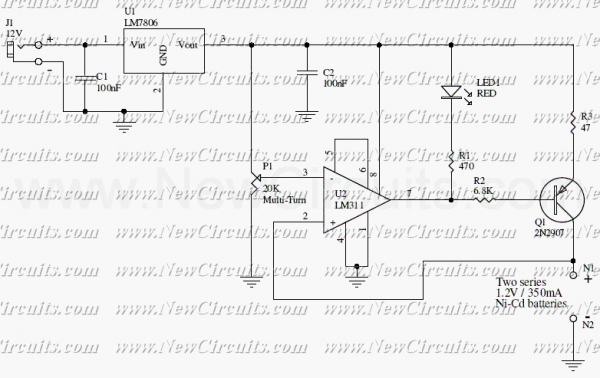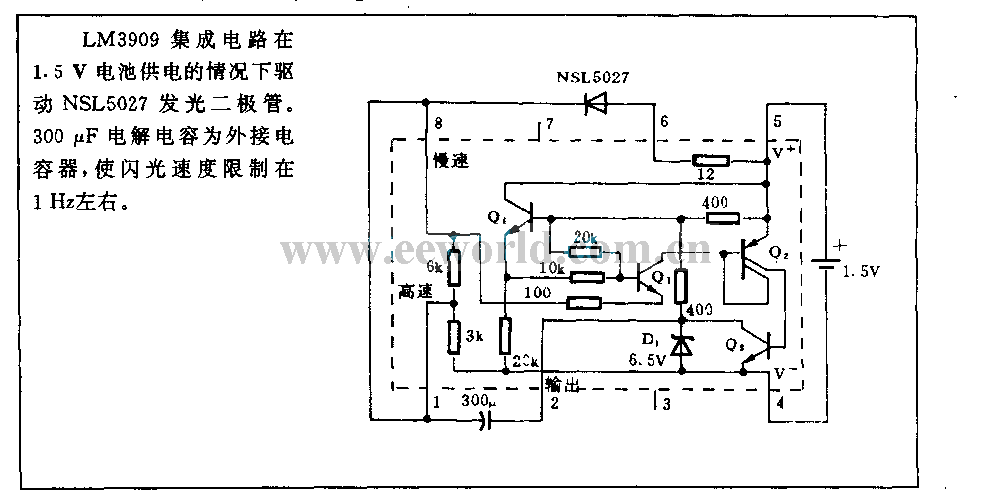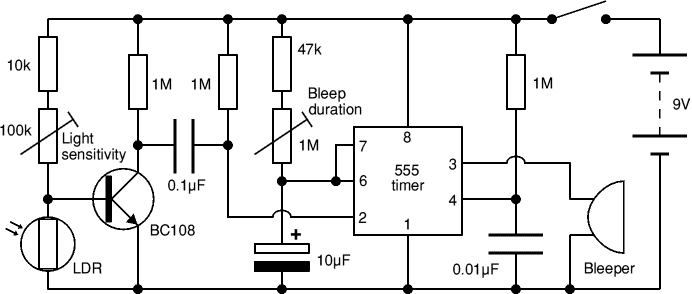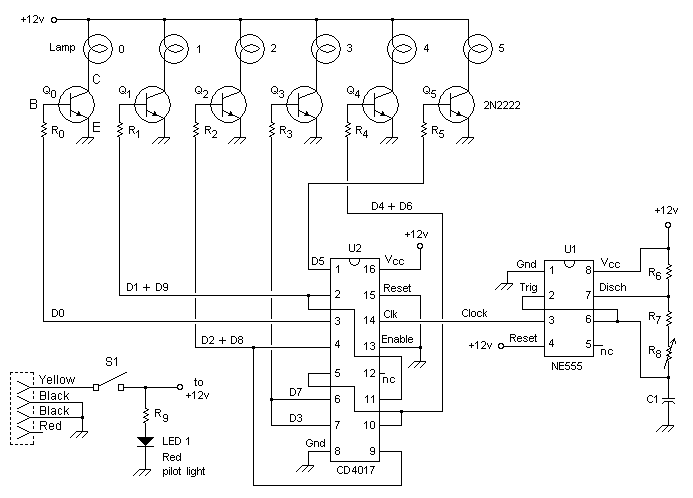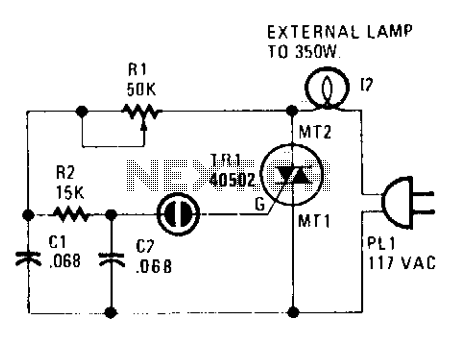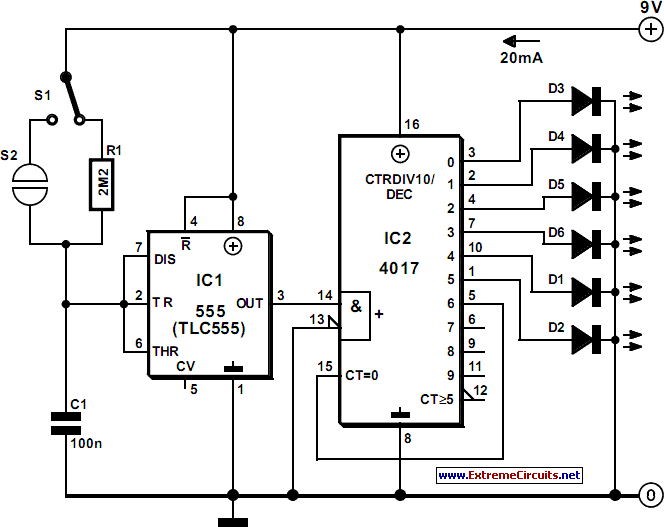
Automatic Light Dimmer
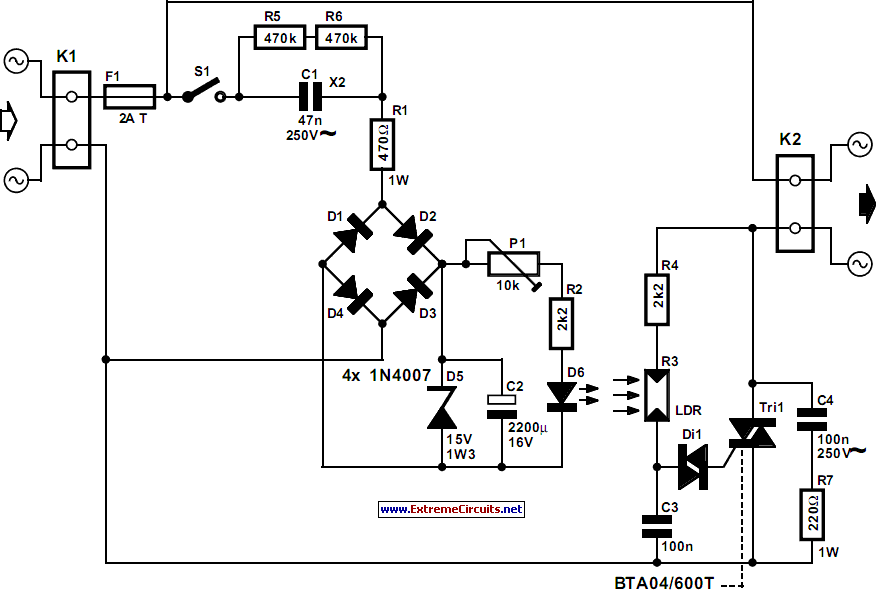
In many instances, the dimmer described here may be integrated into a wall-mounted box that also contains the light switch. It is designed specifically for use with 240 V incandescent lamps. Upon activation, the lamp does not reach full brightness for approximately 400 milliseconds, which is generally imperceptible. When the light is turned off, it remains illuminated at the same intensity for about 20 seconds before gradually dimming. This feature provides the advantage of avoiding immediate darkness when the light is switched off. When the light switch S1 is engaged, capacitor C2 charges through resistors R1, C1, and the bridge rectifier D1-D4. The Zener diode D5 limits the voltage across C2 to approximately 15 V. After a brief period, diode D6 activates, creating a potential difference across the light-sensitive resistor R3, which is sufficient to trigger the triac Tr1, thus turning the light on. When the light switch is deactivated, C2 discharges through potentiometer P1, resistor R2, and D6. As the voltage across C2 decreases, the brightness of the LED diminishes, which in turn reduces the potential difference across R3. The increasing resistance of R3 facilitates phase angle control of the triac, resulting in gradual dimming of the light. The dimming duration can be adjusted using potentiometer P1 within the limits set by the resistor-capacitor network R2-C2. The circuit functions correctly only when the light-dependent resistor (LDR) is shielded from any illumination other than that emitted by the LED. The specific type of LDR is not critical, provided it is not excessively long; in the prototype, a model measuring 5 mm was utilized.
The circuit operates as a dimmer switch for incandescent lamps, utilizing a combination of capacitors, resistors, diodes, and a triac to control light intensity. The integration of the components begins with the activation of switch S1. This initiates the charging of capacitor C2 through the resistive network formed by R1 and C1, along with the bridge rectifier comprising diodes D1 through D4. The rectifier converts the AC voltage to DC, allowing C2 to charge effectively. The Zener diode D5 serves a crucial role in voltage regulation, ensuring that C2 does not exceed 15 V, which is essential for protecting sensitive components in the circuit.
As the circuit stabilizes, the activation of diode D6 signals the presence of sufficient voltage across R3, a light-sensitive resistor that responds to the LED's illumination. The triggering of triac Tr1 occurs when the voltage across R3 reaches a threshold, allowing current to flow to the incandescent lamp, thus illuminating it.
When the light switch is turned off, the discharge path for C2 is established through potentiometer P1, resistor R2, and diode D6. This discharge process is key to the dimming functionality, as the gradual decrease in voltage across C2 leads to a corresponding reduction in the brightness of the LED. The resulting decrease in light intensity causes an increase in the resistance of R3, which in turn adjusts the phase angle of the triac, allowing for a smooth dimming transition rather than an abrupt cutoff.
The adjustable dimming time is a significant feature of this circuit, controlled by potentiometer P1. This flexibility allows users to customize the dimming effect based on personal preference or specific application needs. The design also emphasizes the importance of the LDR's placement, as it must be shielded from external light sources to ensure that the circuit operates as intended. Overall, this dimmer circuit exemplifies a practical application of electronic components to achieve user-friendly lighting control.In many cases, the dimmer presented here may be built into a wall-mounted box containing the light switch. It is intended for use with 240 V incandescent lamps only. When it is fitted, and the light is switched on, the lamp does not come on fully for about 400 ms (which is not noticeable).
When the light is switched off, it stays on unchanged for about 20 s, and then goes out gradually. This has the advantage that it is not immediately dark when the light is switched off. When light switch S1 is turned on, capacitor C2 is charged via R1, C1 and bridge rectifier D1 D4. Zener diode D5 limits the potential across C2 to about 15 V. After a short while, diode D6 lights, whereupon a potential difference ensues across light sensitive resistor R3, which is sufficient to trigger triac Tr1. The light then comes on. When the light switch is turned off, C2 is discharged via P1, R2 and D6. When the potential across C2 drops, the brightness of the LED diminishes, so that the p. d. across R3 also drops. The increasing resistance of R3 effects phase angle control of the triac so that the light is dimmed gradually.
The dimming time may be altered with P1 within the time range determined by network R2-C2. The circuit operates correctly only, of course, when the LDR is not exposed to light other than that from the LED. The type of LDR is not particularly important, as long as it is not too long: in the prototype, a model with a length of 5 mm was used.
🔗 External reference
The circuit operates as a dimmer switch for incandescent lamps, utilizing a combination of capacitors, resistors, diodes, and a triac to control light intensity. The integration of the components begins with the activation of switch S1. This initiates the charging of capacitor C2 through the resistive network formed by R1 and C1, along with the bridge rectifier comprising diodes D1 through D4. The rectifier converts the AC voltage to DC, allowing C2 to charge effectively. The Zener diode D5 serves a crucial role in voltage regulation, ensuring that C2 does not exceed 15 V, which is essential for protecting sensitive components in the circuit.
As the circuit stabilizes, the activation of diode D6 signals the presence of sufficient voltage across R3, a light-sensitive resistor that responds to the LED's illumination. The triggering of triac Tr1 occurs when the voltage across R3 reaches a threshold, allowing current to flow to the incandescent lamp, thus illuminating it.
When the light switch is turned off, the discharge path for C2 is established through potentiometer P1, resistor R2, and diode D6. This discharge process is key to the dimming functionality, as the gradual decrease in voltage across C2 leads to a corresponding reduction in the brightness of the LED. The resulting decrease in light intensity causes an increase in the resistance of R3, which in turn adjusts the phase angle of the triac, allowing for a smooth dimming transition rather than an abrupt cutoff.
The adjustable dimming time is a significant feature of this circuit, controlled by potentiometer P1. This flexibility allows users to customize the dimming effect based on personal preference or specific application needs. The design also emphasizes the importance of the LDR's placement, as it must be shielded from external light sources to ensure that the circuit operates as intended. Overall, this dimmer circuit exemplifies a practical application of electronic components to achieve user-friendly lighting control.In many cases, the dimmer presented here may be built into a wall-mounted box containing the light switch. It is intended for use with 240 V incandescent lamps only. When it is fitted, and the light is switched on, the lamp does not come on fully for about 400 ms (which is not noticeable).
When the light is switched off, it stays on unchanged for about 20 s, and then goes out gradually. This has the advantage that it is not immediately dark when the light is switched off. When light switch S1 is turned on, capacitor C2 is charged via R1, C1 and bridge rectifier D1 D4. Zener diode D5 limits the potential across C2 to about 15 V. After a short while, diode D6 lights, whereupon a potential difference ensues across light sensitive resistor R3, which is sufficient to trigger triac Tr1. The light then comes on. When the light switch is turned off, C2 is discharged via P1, R2 and D6. When the potential across C2 drops, the brightness of the LED diminishes, so that the p. d. across R3 also drops. The increasing resistance of R3 effects phase angle control of the triac so that the light is dimmed gradually.
The dimming time may be altered with P1 within the time range determined by network R2-C2. The circuit operates correctly only, of course, when the LDR is not exposed to light other than that from the LED. The type of LDR is not particularly important, as long as it is not too long: in the prototype, a model with a length of 5 mm was used.
🔗 External reference
